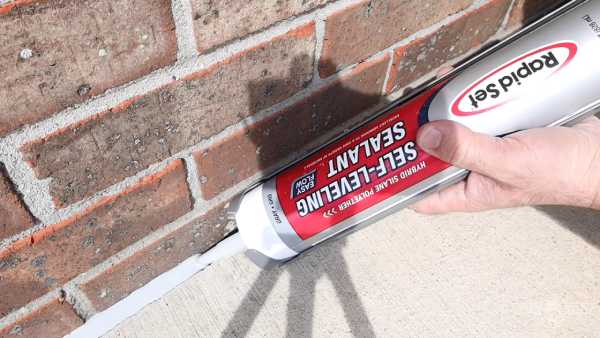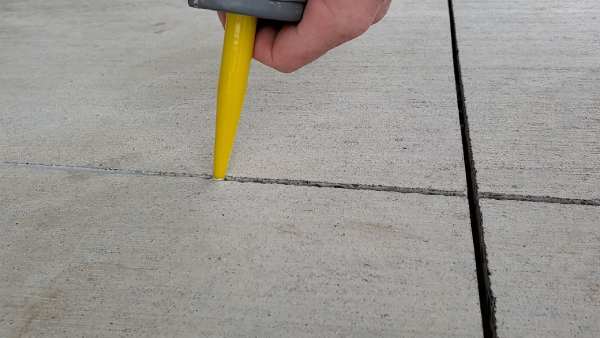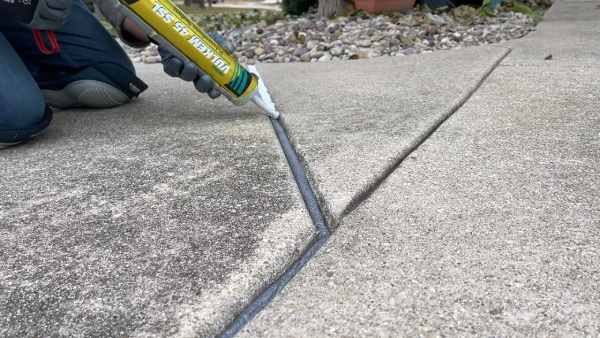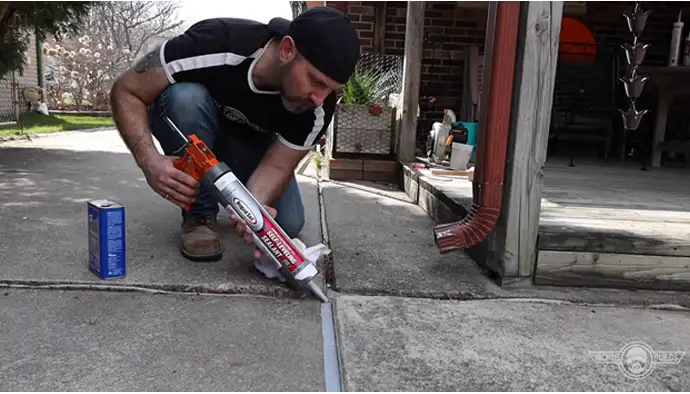Last Updated on June 20, 2023
Are you looking for the best concrete expansion joint filler? If yes, then you’re in luck! Concrete expansion joint fillers are an essential part of any construction project. They provide a seal that prevents water and other substances from entering the internal structure of your building, while also allowing for movement due to temperature and other structural changes.
In this blog post, we’ll discuss what makes the best concrete expansion joint filler and why it’s important to choose the right product for your needs. We’ll also cover some popular options on the market today so you can make an informed decision when selecting your concrete expansion joint filler. So let’s get started!
Top Picks for Best Concrete Expansion Joint Filler:
1. SIKA Sikaflex Self Leveling Sealant
Are you looking for a sealant that will last and give you the results you want? Look no further than Sikaflex Self Leveling Sealant! This premium quality sealant is concrete self leveling caulk with no tooling required.
It levels itself, pours easily and offers permanently elastic properties as well as paintability. Here’s an in-depth look at its features:
Performance
Sikaflex Self Leveling Sealant not only offers self-leveling capabilities, it also pourable with permanently elastic properties so it won’t sag or shrink over time. Plus, you can even paint it once it sets if needed.
Supports
This sealant adheres strongly to concrete and cementitious slabs, making it suitable for a variety of surfaces, particularly driveways and garages. You can be sure that your work will stay put for years to come.
Durability
Sikaflex Self Leveling Sealant is designed to withstand the test of time. Its high durability makes it resistant to ageing and weathering, meaning that your sealant job can stay looking fresh and new for a long time with minimal maintenance needed.
Uses
The versatility of this particular sealant means that it can be used on a variety of surfaces such as driveways, garages and other cementitious areas such as balconies or patios. Plus, since there’s no tooling required, anyone can use this product!
Highlighted Features:
- Seals and waterproofs cracks and gaps
- Pourable and self-leveling for easy application
- Bridges gaps up to 1.5 in. wide
- Excellent adhesion on concrete and cementitious slabs
- Durable and resistant to aging and weathering
2. Dap 18021 Concrete and Mortar Watertight Filler and Sealant
Are you looking for a dependable way to seal cracks in concrete and masonry? Look no further than the DAP 18021 Concrete and Mortar Watertight Filler and Sealant. This product comes in a 10.3 oz. cartridge, and is made from siliconized latex that’s designed to last. Here’s an in-depth look at its features:
Performance
DAP 18021 Concrete and Mortar Watertight Filler and Sealant not only offers reliable crack sealing abilities, but it also eliminates the need for any mortar patching or tuck pointing. The siliconized latex formula reacts with moisture to create a permanent bond that will keep your surfaces watertight for years to come.
Durability
The durable formula of this particular sealant ensures that it remains flexible over time while resisting damage from weather extremes, making it suitable for outdoor use. Plus, since it can be used indoors as well, you can rest assured that this product is built to last!
Usage
The versatility of this particular sealant means that it can be used on a variety of surfaces such as steps, driveways, sidewalks and mortar joints. Plus, since each box contains three cartridges, you can be sure that there’s plenty of sealant to go around!
Highlighted Features:
- Keeps water from seeping into cracks in concrete and masonry
- Can be used on steps, driveways, sidewalks, mortar joints
- Sold in a 3-pack for added value
- Siliconized latex for optimum waterproofing
3. AKONA Pourable Gray Concrete Crack Filler
Are you looking for a reliable way to seal small cracks in concrete? Take a look at the Pourable Gray Concrete Crack Filler!
This light gray product blends in seamlessly with your concrete surfaces, and is great for fixing up cracks that measure up to 1/4 inch deep and wide. Here’s an in-depth look at its features:
Discrete
This Sealant is designed to be discreet, allowing you to enjoy the beauty of your surfaces without having to worry about unsightly black or white sealants ruining the aesthetic. The light gray color ensures that this product blends right into your concrete.
Works In Small Cracks
The crack filling abilities of this product make it ideal for fixing up cracks that measure up to 1/4 inch deep and wide. So no matter how small the crack, you can be sure that this sealant will get the job done.
Dries Quickly
Thanks to its fast drying time, you won’t have to wait days (or even hours!) for this sealant to dry before being able to use your surface again – just one hour after application! Talk about convenient.
No Preparation Required
This product requires no special preparation before use. All you need to do is shake gently, clip tip and apply! Easy as that.
Universal
The universal design of this sealant makes it suitable for a variety of applications such as driveways, sidewalks, patios, steps, garage floors and more!
Highlighted Features:
- Quick and easy to use
- Blends in with concrete surfaces
- No prep required – just shake and go!
- Fights concrete cracks and damage
- Universal application
4. Red Devil 0980 RD 3000 Advanced Self
Are you in need of a powerful sealant with superior adhesion and durability? Then the Red Devil 0980 RD 3000 Advanced Self-Leveling Sealant is just what you need! This low-VOC sealant forms a waterproof, flexible and durable seal. Here’s an in-depth look at its features:
Low-VOC
The low VOC content of this particular sealant means that it’s a suitable choice for both indoor and outdoor applications. It will not only protect your surfaces from water damage, but it also won’t contribute to air pollution.
Flexible and Durable
This sealant is designed to be both flexible and durable, making it perfect for sealing joints, edges and corners that can deform over time due to water pressure or temperature changes. The waterproof formula ensures that your surface remains protected against environmental factors like wind, rain and snow.
Waterproof Seal
The waterproof formula helps to keep your surfaces safe from moisture related damage. The elasticity of this particular sealant allows it to move with changing temperatures without cracking or separating, ensuring a tight fit between your substrates over time.
Excellent Adhesion
Due to its excellent adhesion properties, this sealant can securely bond to porous materials such as concrete and brick without any primers or other preparation techniques needed. Plus, if you need extra protection against water damage, the Red Devil 0980 RD 3000 is perfect for use on roofs as well!
Highlighted Features:
- Low-VOC for a safer, healthier work environment
- Flexible and durable for a variety of applications
- Waterproof seal prevents leaks and protects surfaces
- Excellent adhesion creates a lasting bond
5. AWF PRO Sikaflex 1C SL 10 oz Limestone
Are you in the market for a high performance sealant that offers great coverage, durability, and elasticity? Look no further than the Sikaflex 1C SL 10 oz Limestone! This single component sealant is perfect for sealing horizontal expansion joints in concrete. Here’s an in-depth look at its features:
High Performance
Sikaflex 1c SL is designed to be highly performant, providing superior protection against environmental factors such as wind, rain and snow. Plus, it’s also incredibly durable, meaning it won’t crack or separate over time.
High Elasticity
This sealant offers excellent elasticity, allowing it to move with changing temperatures without cracking or separating. The tough yet flexible consistency makes this product ideal for use on soft or rigid surfaces alike.
Great Coverage
The coverage of this sealant ensures that your surfaces remain protected against water damage and degradation over time. Plus, thanks to its low VOC content it can be safely used indoors and outdoors with no worries about air pollution.
Awesome Value Kit
Our value kit includes everything you need to get started – 10oz tube of Sikaflex 1C SL plus instructions! Get ready to enjoy the protection of a high-quality sealant without having to break the bank.
Tested and Approved
Meets Federal Specifications TT-S-00230C & TT-S-001543A for highway and transportation applications – so you know that this product has been tested and approved by experts!
Highlighted Features:
- Sikaflex 1C SL is a single component, self leveling, premium grade polyurethane sealant
- Cures to a tough, durable and flexible consistency
- Resists aging and weathering
- Tested and approved
6. DCP Donseal PU440 Concrete Sealant
Are you in the market for a high-quality sealant that can be applied to both horizontal and vertical surfaces?
Look no further than the DCP Donseal PU440 Concrete Sealant! This non-sag polyurethane concrete sealant cures by reacting with air humidity to form a highly elastic expansion joint material. Here’s an in-depth look at its features:
High-Quality Sealant
This sealant is designed to be highly durable and resistant to weathering, meaning that it will stay flexible and crack-free even after periods of frequent exposure to wind, rain and snow. It won’t sag or slump when applied vertically either, making it perfect for sealing complex shapes without needing additional support from backer rods or similar products.
Different Base Materials
The DCP Donseal PU440 can be used on different base materials such as concrete, masonry and metal with no problems. This makes it easier and more efficient to use one product rather than multiple products for each type of surface.
Horizontal & Vertical Applications
This sealant can be applied both horizontally and vertically without the need for additional support from backer rods or similar products. With this flexibility, you can easily create complex shapes while still enjoying the protection of a premium sealant.
Extra Features
The extra features of this particular sealant include sound absorption properties as well as flame retardancy, making it perfect for applications where these are required. Plus, it meets Federal Specifications TT-S-00230C & TT-S-001543A for highway and transportation applications – so you know that this product has been tested and approved by experts!
Standard Application Process
The standard application process for the DCP Donseal PU440 is easy – simply apply a bead along your desired area then tool it with a trowel or other suitable device (if necessary). No primers or preparation techniques are needed before application either!
Highlighted Features:
- Non-sag formula for easy application
- Use on different base materials
- Can be used horizontally and vertically
- Extra features – paintable and fits interior design
- No special tools or equipment needed
How to Choose the Best Concrete Expansion Joint Filler for Your Project

When it comes to construction and improvement of commercial, industrial or residential settings, concrete expansion joint fillers play an important role. Expansion joints are a necessary part of any structure as they accommodate movements due to temperature changes, shrinkage and Creep.
The right type of filler will ensure the movement is both smooth and consistent. There are four types of concrete expansion joint fillers; flexible foam fillers, semi-rigid fillers, rigid fillers, and grout or mortar based fillers.
Each type has its own advantages and limitations with regards to movement accommodation and durability. In this article we will discuss each type in further detail so that you can make an informed decision when selecting the right joint filler for your project.
Types of Concrete Expansion Joint Fillers
Flexible Foam Fillers:
Flexible foam fillers are some of the most commonly used concrete expansion joint fillers due to their low cost, ease of installation and flexibility in accommodating minor movements across large areas. They come in a variety of sizes such as quarter inch thick sheets up to two inches thick depending on the application requirements.
These materials are composed of polymeric foam which absorbs moisture from the environment creating a seal against water infiltration into the foundation or slab joint causing mold growth or structural damage due to freeze thaw cycles.
The flexibility of these materials also allows for thermal expansion or contraction during seasonal temperature changes without compromising the integrity of the material itself.
Semi-Rigid Fillers:
Semi-Rigid Fillers are also widely used in commercial applications due to their ability to accommodate larger movements while still providing adequate support at the joint edge between slabs, walls and other substrates.
This type of material provides superior resistance against ultraviolet light degradation when compared with flexible foam fillers making them more suitable for outdoor installations such as pavements and sidewalks.
Semi rigid fillers usually consist of polyvinyl chloride (PVC) strips that are performed into specific shapes such as staves or I-beams which provide superior strength while allowing for small amounts expansion/contraction along their length without compromising their structural integrity over time.
Rigid Fillers:
Rigid Fillers are used mainly in high load bearing applications where large amounts of movement must be accommodated across long distances. This type is best suited for driveways, elevated decks, bridge approaches etc., where additional stability is required along with high load bearing capacity for vehicles or other heavy loads crossing over them frequently.
The material consists mainly of high strength polymers such as polyethylene (PE) combined with filler components such as silica sand which provides additional rigidity against lateral loads which would otherwise cause premature failure due to fatigue induced by constant pounding from vehicular traffic over long periods .
Grout or Mortar Based Fillers:
Grout or Mortar Based Fillers are designed mainly for small scale projects within residential settings where aesthetics matters more than durability & strength requirements expected from larger commercial structures subjecting heavy footfall & vehicle traffic throughout its active life span .
These materials typically come premixed with cementitious grouts & aggregates usually having a thick paste like consistency requiring minimal effort during installation but providing decent resistance against cracking & spalling under normal environmental conditions if properly sealed & cured prior usage .
Factors to Consider When Buying a Concrete Expansion Joint Filler

Concrete expansion joint fillers are an important component of any concrete structure. They are used to provide a physical and flexible barrier between the two sides of a concrete slab or wall, preventing both movement and the buildup of water.
When selecting a concrete expansion joint filler, there are many factors that must be taken into consideration. These include the type of material being used for the filler, the environment in which it will be used, its expected lifespan, local climate conditions, and the availability of maintenance service providers.
This article will discuss each factor in detail to help you make an educated decision when purchasing a concrete expansion joint filler.
Type of Material Being Used for the Filler
When it comes to choosing a material for a concrete expansion joint filler, there is no shortage of options available. Polyurethane foam fillers are one popular choice due to their excellent insulating properties and ability to resist UV degradation.
Asphaltic tapes and caulks offer another viable solution as they can effectively bridge small joints while providing superior adhesion between surfaces. Elastomeric sealants and butyl rubber tapes offer great flexibility while neoprene and EPDM rubbers, silicone sealants, and epoxy resins all provide excellent waterproofing capabilities.
It’s important to take into account what kind of performance characteristics you need from your filler before making your final decision as different materials may be better suited for certain applications.
The Environment in Which the Filler Will Be Used
The environment in which the filler will be used is also an important factor to consider when selecting your expansion joint filler. If the application is internal such as in bathrooms or kitchens where temperatures are more stable then flexible materials with low temperature ranges may suffice.
However if it is an external application exposed to heat or cold extremes then materials designed with higher temperature ranges should be chosen accordingly.
The expected lifespan is another key factor that needs to be taken into account when selecting your material; some products such as butyl rubber have been known to last up to 20 years whereas other materials such as asphalt based fillers have shorter lifespans in comparison (around 8-10 years).
The Local Climate Conditions
The local climate conditions should also be taken into consideration when selecting an expansion joint filler as extreme weather can significantly impact its durability over time.
In areas prone to freezing temperatures it is important to select a product that can withstand both hot and cold weather without compromising its integrity or performance characteristics; elastomeric sealants tend to perform well under these types of conditions due to their flexibility and ability to “self-heal” after contraction/expansion cycles caused by temperature fluctuations throughout the year.
Similarly if you live in wetter climates then waterproofing characteristics should also be considered when selecting your product; neoprene or EPDM rubber based fillers typically perform well under these types of environments due their excellent waterproofing capabilities combined with good adhesion properties and flexibility over time.
The Availability of Maintenance Service Providers
Finally it’s important to consider whether maintenance service providers are available locally who can assist you with installation and/or repairs if needed over time; this could save you time money down the road so it’s worth checking on beforehand even if it isn’t necessarily required at this stage (many suppliers offer warranties covering faulty products).
Additionally, make sure that any potential supplier has been certified by industry standards bodies such as ASTM International (formerly known as American Society for Testing Materials), ensuring that their products meet all safety requirements necessary for public use cases where applicable (e..g restaurants/hotels etc.).
What do you fill concrete expansion joints with?
Concrete expansion joints are typically filled with a flexible and compressible material, such as backer rod or self-leveling sealant. Backer rod is a semi-rigid foam material that is placed into the joint before the sealant.
This helps reduce the amount of sealant needed, while also preventing the sealant from bonding to the sides of the joint. The backer rod should be installed so that it is slightly compressed, providing a cushion for the sealant to rest against.
Self-leveling sealants are liquid materials that can be poured into an expansion joint and then allowed to cure, forming an elastic bond between two concrete surfaces. Self-leveling sealants offer superior flexibility and durability when compared to traditional caulk materials.
Can you use foam for expansion joints?

Foam products can be used for expansion joints, although they may not provide the same level of protection as other materials such as backer rods or self-leveling sealants. Foam products are primarily designed to fill larger gaps than those found in typical expansion joints and may not provide sufficient flexibility or durability over time.
It is recommended that foam products only be used in applications where they will remain undisturbed by traffic or movement of adjacent structures.
How do you stop an expansion joint from leaking?
To stop an expansion joint from leaking, it must be filled with a flexible and compressible material such as a backer rod or self-leveling sealant. The material should be installed so that it is slightly compressed, providing a cushion for the sealant to rest against.
Once installed, it should be checked periodically for signs of wear or damage that could lead to leaks over time. Additionally, any cracks in adjacent concrete surfaces should be repaired prior to filling the joint in order to prevent water infiltration through those areas.
How thick should a concrete expansion joint be?
The thickness of a concrete expansion joint depends on several factors including the type of structure being supported, local building codes, and environmental conditions such as temperature and humidity levels.
Typically, for residential structures, an expansion joint should have a minimum width of ¼ inch (6 mm) up to 1 inch (25 mm). For commercial applications involving heavier loading conditions such as bridges or roadways, thicker joints may be necessary up to 4 inches (100 mm).
How do you fill old concrete expansion joints?
Old concrete expansion joints can often become damaged due to weathering and erosion over time. In order to properly fill old joints with a flexible and compressible material such as backer rod or self-leveling sealant, any debris within the joint must first be removed so that there is adequate room for proper installation of the material.
After removing any debris from within the joint cavity, it is important that any cracks in adjacent surfaces are repaired prior to filling with new material in order to prevent water infiltration through those areas.
Finally after sealing has been applied evenly across the surface around each end of the joint cavity, a backer rod should then be inserted into position followed by application of additional self-leveling sealant which will cure over time providing added strength and flexibility at these points along with increased protection against further damage due to wear or erosion over time
Conclusion
In conclusion, concrete expansion joint fillers are an important part of any construction project. It’s important to choose the right product for your needs in order to ensure that it provides a permanent seal and keeps moisture out of your building’s internal structure.
There are a variety of different types available on the market, including epoxies, polyurethanes, silicones, and more. All of these products have their own unique benefits and should be considered depending on the specific application.
Researching each type thoroughly will help you make an informed decision when selecting your optimal concrete expansion joint filler solution.


